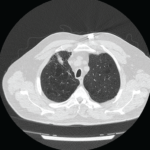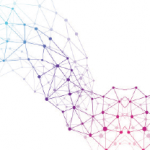Discussion
Hypertrophic osteoarthropathy is a rare rheumatologic condition characterized by digital clubbing, periostosis and joint swelling.1 Some patients with HOA may present with a painful arthropathy prior to the onset of clubbing, which can mimic an inflammatory arthritis.2 In the case of our patient, we were initially concerned she might have an inflammatory arthritis due to her elevated C-reactive protein with prominent morning stiffness in the ankles, knees and interphalangeal joints of the hands.
HOA has primary and secondary forms. The primary form is known as pachydermoperiostosis.3 It is a hereditary condition, with a predominance of males afflicted (in a 9:1 ratio) by the disorder.3 In contrast to the secondary forms of HOA, the primary form is more likely to have prominent skin hypertrophy.3
Secondary forms of HOA are of particular concern to rheumatologists, because an underlying disease process may be masked by the HOA. Yao et al. reported in a literature review that approximately 80% of HOA cases are due to a primary or secondary pulmonary malignancy.4 Aside from pulmonary malignancies, many other pathologic processes can contribute to the onset of secondary HOA (see Tables 1 and 2 for a summary, below).
Table 1: Causes of Secondary HOA5
| Pulmonary Diseases | Cardiac Disease | Liver Disease |
|---|---|---|
| Cancer | Infective endocarditis | Cirrhosis |
| Metastasis | Congenital cyanotic disease | Carcinoma |
| Mesothelioma | Biliary atresia | |
| Pulmonary fibrosis | Primary sclerosing cholangitis | |
| Cystic fibrosis | ||
| Chronic infections | ||
| Arteriovenous fistula |
Localized forms of secondary HOA, involving one or two limbs, have also been described in medical literature.5 These localized forms are generally due to marked endothelial injury.5 Aneurysms, infective arteritis, patent ductus arteriosus and hemiplegia are examples of disorders causing these limited forms of HOA.5
Non-steroidal anti-inflammatory drugs (NSAIDs) are effective in alleviating pain in most patients with HOA.5 Case reports have been published regarding the use of intravenous bisphosphonates in instances of pain that did not respond to oral NSAIDs.6,7 However, the definitive management of HOA is truly predicated on the treatment of the underlying disease process.5
Table 2: Causes of Secondary HOA, Continued5
| Gastrointestinal Disease | Miscellaneous Conditions |
|---|---|
| Chronic infections | Thymoma |
| Laxative abuse | POEMS syndrome |
| Gastrointestinal polyposis | Thalassemia |
| Cancer | Persistent ductus arteriosus |
| Crohn’s disease | Myelofibrosis |
| Ulcerative colitis | |
| Achalasia |
Ito et al. reported that HOA symptoms may improve with surgical resection of the malignancy.8 Systemic chemotherapy may also improve HOA symptoms.8 The same principle applies to the successful treatment of infectious endocarditis or other secondary cause of HOA.5
Our patient only recently started chemotherapy and radiation treatments for her non-small cell carcinoma, but her signs and symptoms of HOA are expected to improve with successful treatment of the primary pulmonary malignancy.
Conclusion
Our case highlights a rare rheumatologic presentation of hypertrophic osteoarthropathy. An underlying cause of our patient’s clubbing and arthralgias was not readily apparent, and this necessitated an aggressive workup for an underlying cause. This, in turn, led to the discovery of an underlying pulmonary malignancy. This case demonstrates the need for awareness of malignancy masquerading under the guise of arthralgias in patients in whom another etiology cannot be determined in the presence of abnormal clinical findings, such as clubbing.

